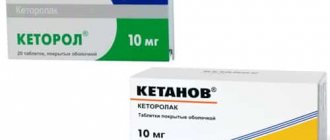The most common complaint from patients is pain. They can be anywhere - in bones, joints or muscles. Most often this happens to older people. But in the twenty-first century, pain as a symptom is “younger” and is increasingly found among young people.
Pain is a natural reaction of the body. It is a kind of alarm signal about the state of health. It is sometimes extremely difficult to independently determine the cause of pain, which means it is better to immediately go to the doctor.
Painkiller injections
In this article we will talk in detail about the nature of pain and what effective pain-relieving injections are available to help quickly get rid of discomfort.
Top 10 most effective painkillers.
November 17, 2022
8187
4.9
2
Content
- How to choose pain pills
- The best painkillers
- Nonsteroidal anti-inflammatory drugs for pain
- Aspirin Express
- Nurofen Forte
- Dexonal
- Ibuprofen
- Painkillers antispasmodics
- No-Shpa
- Drotaverine
- Spasmonet
- Combination pain relievers
- Pentalgin
- Solpadeine Fast
- Safiston
Analgesics (painkillers) help relieve any pain in the body. You can buy mild painkillers at any pharmacy without a prescription, but strong (narcotic) drugs are sold only by prescription and are prescribed by a doctor, who determines the required dosage.
We have compiled a list of the most effective over-the-counter pain pills based on doctor recommendations and patient reviews. Our rating includes non-steroidal anti-inflammatory drugs, antispasmodics and drugs with combined effects. Analgesics help reduce headaches, dental, muscle, joint and other types of pain. If you decide to buy a painkiller, be sure to pay attention to the popularity of the company that produces the drug, because only well-known pharmaceutical manufacturers carefully monitor the quality and safety of their products.
Types of pain
There are different types of pain.
Experts divide all pain into two categories:
- acute, appears suddenly, usually due to injury, does not last long;
- chronic, lasts a long time, occurs as a result of chronic inflammation.
When taking medications for pain, you should consider the type of pain. In some cases, it is prohibited to use painkillers. For example, with acute abdominal pain. This way the disease can be veiled, as a result doctors will not be able to accurately diagnose the disease.
How to choose pain pills
If you decide to buy a painkiller, be sure to read our recommendations.
- The first thing you need to pay attention to when you buy pain pills is the age limit.
This is especially important if you are buying the drug for a child. If you do not follow this rule, there may be health problems due to inappropriate concentration of the active substance. - To relieve, for example, a headache or toothache, choose narrowly targeted drugs.
If pain occurs in different parts of the body, it is better to buy
complex action products. - determine how safe a painkiller is
for your health by studying the list of its contraindications and side effects. The smaller it is, the better, of course. - It is desirable that pain tablets contain an average concentration of the active substance.
If there is little active ingredient, you will have to take the drug more often. If, on the contrary, there is a lot, you need to carefully monitor so as not to overdo it with the dosage. - You don’t need to be guided only by the speed of action of painkillers.
Typically, drugs that quickly relieve pain do not work for long and have a long list of contraindications. - It is also important that pain pills do not contain many active ingredients
- then there will be a minimum of negative reactions. Several components are allowed only in broad-spectrum preparations. - Try to choose a product from a well-known pharmaceutical manufacturer
- this way you will minimize the risks of health problems. - Analgesics are needed only in extreme cases; do not take them at the slightest pain.
Before buying a painkiller, study information about it on the Internet, and most importantly,
consult your doctor.
Types of painkillers
Remedies for pain are divided into several types:
- Narcotic drugs. They depress the nerve centers that respond to pain. As a rule, such drugs cause relaxation, euphoria, and drowsiness. Such products are issued only with a medical prescription.
- Non-narcotic drugs. They do not affect the nervous system, do not cause drowsiness or euphoria. Therefore, such drugs are sold without a prescription. They usually also have anti-inflammatory and antipyretic properties.
Non-narcotic painkillers are divided into groups:
- NSAIDs (non-steroidal drugs) have an anti-inflammatory effect, lower temperature, relieve pain;
- Antispasmodics for spasms;
- mixed preparations eliminate spasms and pain.
Narcotic drugs are not commercially available and therefore are not used for self-medication. The most common drugs are NSAIDs. They quickly relieve pain and inflammation, but have many contraindications and side effects. They are especially dangerous in case of ulcerative lesions of the gastrointestinal tract or if they are suspected. Because they can cause gastric bleeding and aggravate ulcers of the stomach and intestinal mucosa. This can sometimes be fatal.
The best painkillers
Our list contains only the most proven and effective painkillers from well-known manufacturers. This means that the drugs presented have a minimum of side effects and contraindications and are as safe as possible for health. These pain pills are often prescribed by doctors, and patients say they are effective.
Painkillers must be prescribed by a doctor
Photos from open sources
Aspirin Express
These effervescent pain relief tablets contain 500 mg of acetylsalicylic acid. After taking this pill, the headache will go away within 15 minutes. "Aspirin Express" relieves pain, relieves inflammation and works as an antipyretic. The drug is prescribed to patients over 25 years of age, and it is important that the person does not have diseases of the gastrointestinal tract, kidneys or liver. Aspirin Express is prohibited for pregnant and lactating women. For migraines, you need to dissolve two effervescent tablets in a glass of water. 1 tablet – 1 g (you can take no more than 3 g of the drug per day). If you exceed the permissible dosage of these pain pills, side effects such as dizziness, nausea, vomiting, and the development of an allergic reaction are possible. You should not take Aspirin Express for more than three days (without consulting your doctor). The drug has a complex effect, a quick effect, a convenient release form, and no side effects. You can read the contraindications in the instructions.
Aspirin Express
Bayer AG, Germany
Antipyretic, analgesic, anti-inflammatory, antiplatelet agent, NSAID for the symptomatic relief of headache, toothache, sore throat, menstrual pain, muscle and joint pain, back pain;
- increased body temperature during colds and other infectious and inflammatory diseases (in adults and children over 15 years of age). from 5
5.0 1 review
175
- Like
- Write a review
Application
The optimal time to take the tablets was after a meal, washed down with at least half a glass of clean water. The dosage is selected individually, taking into account the patient’s condition and the purpose of therapy. To reduce the risk of negative side reactions, you should take the minimum effective dose that relieves pain.
The recommended daily dosage, according to the instructions for use for children over 15 years of age and adults, is up to 2 tablets in 2-3 three divided doses. If indicated, it is allowed to take no more than 6 tablets per day. The duration of taking the drug is no more than 3 days.
Byrol tablets, which are available in pharmacies without a prescription, interact with many other medications. Therefore, it is strictly forbidden to use them without a doctor’s recommendation. The drug should be stored out of the reach of children. Shelf life: 3 years at a temperature not exceeding 25°C.
Nurofen Forte
This pain reliever is the best in its category. Nurofen Forte tablets help with muscle, headache, toothache and joint pain. The drug has very few contraindications due to the content of a small amount of active ingredients. Nurofen Forte is easy to use and has virtually no side effects. Tablets are prescribed from the age of 12; you can take the drug three times a day, one tablet (at equal intervals of 6 hours). You can be treated with Nurofen Forte for no longer than two to three days, then you need to take a week break. Tablets have a wide spectrum of action.
Nurofen Forte
Reckitt Benckiser Healthcare International Ltd, UK
NSAIDs to eliminate: Headache;
migraine; toothache; algodismenorrhea; neuralgia; backache; myalgia; rheumatic pains; fever with influenza and ARVI. from 9
5.0 1 review
607
- Like
- Write a review
Dexonal
Although these pain relief pills are relatively expensive, they make up for this with their effectiveness and safety. This is a drug with a narrow spectrum of action; Dexonal is usually prescribed for pain in the bones and muscles. The tablets have quite a few contraindications, since they contain many components. In addition, the painkiller has strict age restrictions. The drug is prohibited for patients under 18 years of age. Side effects are rare if the required dosage is followed exactly. If the rules for taking Dexonal are not followed, side effects such as disruption of the gastrointestinal tract and cardiovascular system are possible. Painkiller tablets are easy to use, have convenient packaging, are most effective, but are expensive.
Dexonal
Obolenskoye (OBL Pharm), Russia
The drug Dexonal is a non-steroidal anti-inflammatory drug.
It has analgesic, anti-inflammatory and antipyretic effects. The analgesic effect occurs 30 minutes after taking the drug Dexonal orally, the duration of the therapeutic effect reaches 4–6 hours from 220
5.0 6 reviews
956
- Like
- Write a review
Ibuprofen
The active ingredient in these pain pills is ibuprofen, and its low concentration in the drug is excellent for treating pain in those who cannot afford an expensive drug. But the cheapness of Ibuprofen does not mean that it is ineffective. On the contrary, the tablets relieve pain well and begin to act as quickly as possible. Other advantages include minimal likelihood of overdose and ease of use. Ibuprofen is prohibited for children under 6 years of age. It is advisable to take the medicine after consulting a doctor in order to take into account all possible contraindications.
Ibuprofen
OJSC Pharmstandard-Leksredstva, Russia; Slavyanskaya Pharmacy, Russia; Rafarma, Russia; CJSC VERTEX, Russia; PJSC "Biokhimik", Russia; EKOlab, Russia; "Moskhimfarmpreparaty" named after. N. A. Semashko, Russia; Belmedpreparaty, Belarus; PJSC "Biosintez", Russia; Borisov medical plant drugs, Belarus; Sintez OJSC, Russia; JSC "Tatkhimfarmpreparaty", Russia; Novopharm-Biosintez LLC, Ukraine
Symptomatic treatment: - tension headaches and migraines;
- joint, muscle pain, - pain in the back, lower back, radiculitis; - pain when ligaments are damaged; - toothache; - painful menstruation; — febrile conditions during colds, flu; - rheumatoid arthritis, osteoarthritis. NSAIDs are intended for symptomatic therapy, reducing pain and inflammation at the time of use, but do not affect the progression of the disease. from 16
4.5 2 reviews
1552
- Like
- Write a review
How does the pill know where it hurts? FAQ about painkillers
Pain occurs in two cases:
- Due to external stimuli that excite nerve cells, and they send a signal to the brain, pain signals come. For example, accidentally touching a hot surface;
- Due to damage or dysfunction of the nerves themselves. In this case, the cells produce substances called prostaglandins, which act on the nerve endings in the body and stimulate them to transmit a signal to the brain about which area hurts and how much it hurts.
Painkillers work by preventing damaged cells from releasing prostaglandins throughout the body, so they always “find” the area that needs to be numbed. Moreover, almost all painkillers only relieve the symptom without affecting the causes of its occurrence. Therefore, if you are experiencing severe pain, be sure to consult a doctor!
How do NSAIDs work?
Nonsteroidal anti-inflammatory drugs (NSAIDs, NSAIDs) inhibit special substances in the body - cyclooxygenases, enzymes that are involved in the production of prostaglandins. An example of an NSAID is Ibuprofen Medisorb. The capsule dosage form allows for faster action.
How do analgesics work? Like NSAIDs, they block the enzyme responsible for the synthesis of prostaglandins and reduce the conduction of pain impulses. Analgesics also increase the sensitivity threshold in the thalamus, which leads to an improvement in dental, joint, and headache pain, and have an antipyretic effect. Examples of non-narcotic analgesics are Paracetamol Medisorb, Analgin Medisorb.
How do antispasmodics work? A spasm is a prolonged painful contraction of a muscle. Antispasmodics affect the sympathetic nervous system and reduce muscle tone.
Examples of antispasmodics are “Drotaverine MS”, “Papaverine hydrochloride MS”.
How do triptans work?
This is a special group of medications for the relief of migraine attacks; they are not suitable for eliminating other types of pain. Triptans reduce nerve sensitivity and neurogenic inflammation, eliminate nausea and photophobia associated with migraine.
Why do cancer patients require narcotic painkillers? When internal organs and tissues are involved in the pathological process, cancer patients may experience severe visceral pain due to tumor growth. At first, patients are prescribed broad-spectrum NSAIDs, but as the disease progresses, their effect to relieve pain becomes insufficient. Then patients are prescribed potent anti-inflammatory analgesics. At the last stage, cancer patients receive narcotic analgesics - opiates. They work by inhibiting the conduction of painful stimuli in the central nervous system.
Important: all painkillers have contraindications! Before use, consult your doctor, always read the instructions for medical use of drugs!
No-Shpa
Typically, “No-Shpu” is prescribed for spasms of smooth muscles of the gastrointestinal tract, spasms of the biliary and urinary tracts, headaches, and painful menstruation. This drug for pain is one of the most popular because it is inexpensive, most effective and quickly begins to act. In addition, No-Shpa has few contraindications and the risk of overdose. "No-Shpa" contains six components that are safe for health, which very rarely cause side effects. Painkillers are prescribed for adults and children over 6 years of age.
No-shpa
Chinoin, Hungary
Antispasmodic drug used for: Spasms of smooth muscles in diseases of the biliary tract: cholecystolithiasis, cholangiolithiasis, cholecystitis, pericholecystitis, cholangitis, papillitis;
- spasms of smooth muscles of the urinary tract: nephrolithiasis, urethrolithiasis, pyelitis, cystitis, bladder spasms. As an auxiliary therapy: - for spasms of smooth muscles of the gastrointestinal tract: peptic ulcer of the stomach and duodenum, gastritis, spasms of the cardia and pylorus, enteritis, colitis, spastic colitis with constipation and irritable bowel syndrome with flatulence; - for tension headaches; - for dysmenorrhea (menstrual pain). from 50
4.5 2 reviews
1691
- Like
- Write a review
Drotaverine
Perhaps one of the most inexpensive and effective antispasmodics prescribed for pain in the gastrointestinal tract and spasms of the smooth muscles of internal organs. "Drotaverine" has very few contraindications: childhood, intolerance to the drug components, severe liver and kidney failure. Drotaverine contains a low concentration of the active substance, so the risk of side effects is practically eliminated. Due to its low cost, this painkiller is available to everyone. Among the disadvantages is that sometimes Drotaverine is difficult to find in pharmacies.
Drotaverine
Planet Organics; Borisov medical plant drugs, Belarus; NPC Pharmzashchita, Russia; PJSC "Biosintez", Russia; Ozon LLC, Russia; FSUE "Armavir Biofactory", Russia; PJSC "Biokhimik", Russia; Deco, Russia; JSC Dalkhimfarm, Russia; Novosibkhimpharm OJSC, Russia; Vifitech/Vilar, Russia; Update, Russia; Sintez OJSC, Russia; JSC PharmProject, Russia; PJSC Valenta Pharm, Russia; "Moskhimfarmpreparaty" named after. N. A. Semashko, Russia; JLLC "Lekpharm", Belarus; Medisorb, Russia; Obolensk pharmaceutical enterprise, Russia; Solopharm, Grotex LLC, Russia; Ellara MC, Russia
Spasm of smooth muscles of the urinary and biliary organs (renal colic, pyelitis, tenesmus, biliary colic, intestinal colic, dyskinesia of the biliary tract and gallbladder of the hyperkinetic type, cholecystitis, postcholecystectomy syndrome).
Spasm of smooth muscles of the gastrointestinal tract (usually as part of combination therapy): pylorospasm, gastroduodenitis, gastric and duodenal ulcers, spastic constipation, spastic colitis, proctitis. Tensor headache. Dysmenorrhea, threatened miscarriage, threatened premature birth, postpartum contractions. When conducting some instrumental studies, cholecystography. from 12
5.0 1 review
919
- Like
- Write a review
Painkillers and anti-inflammatory drugs
Pain is an integral part of our life. It is a kind of protective reaction that occurs in response to irritation of pain receptors, which are located in various organs and tissues. The appearance of pain indicates problems, serious diseases and pathological processes occurring latently in the body. It indicates what poses a threat to human health, helping to identify and eliminate the problem. Pain is an alarming signal that should never be ignored.
However, pain has not only positive, but also negative qualities. Whatever painful sensations a person experiences: nagging, sharp, pulsating or dull, they unsettle him, disrupting his usual way of life. Each of us, having barely felt the pain, strives to eliminate it as quickly as possible. But how to do that? How to remove pain of varying nature and intensity? Unfortunately, it is extremely difficult to cope with these unpleasant sensations on your own and, perhaps, only masters of self-control and yoga can do it. Other people have to resort to painkillers. Painkillers or analgesics are medications that relieve pain. Depending on the main active ingredient present in their composition and the form of release, they can affect the peripheral nervous system, brain, or have a local analgesic effect.
Very important! Painkillers do not cure! You've probably already heard that painkillers only eliminate pain without affecting the cause of the pain. In other words, with the help of analgesics you can only temporarily get rid of unpleasant sensations. A disease or other pathological process in the absence of proper drug treatment will continue to progress, exacerbating attacks of pain. Therefore, it is very important to immediately consult a doctor if you have persistent and severe pain of any origin!
Today, medicine offers a wide range of painkillers, presented in the form of ointment, powder, gel, drops, tablets and injection solution. You should choose an anesthetic based on the location of the pain and the cause that caused it. Let's look at an example. You hurt your arm and are now suffering from severe and excruciating pain. In order to eliminate pain in this situation, you need to use analgesics presented in the form of an ointment or gel (Finalgon, Lyoton, Nise-gel, etc.), since the cause of pain is local damage to the tissues and skin. If the pain does not disappear within 2–3 days, be sure to consult a doctor.
Based on their chemical nature and pharmacological properties, painkillers are divided into two main groups: non-narcotic and narcotic drugs.
Non-narcotic painkillers . They are analgesic drugs that do not have a significant effect on the central nervous system. This group of analgesics does not have a hypnotic or sedative effect and is not addictive. They are also called non-steroidal anti-inflammatory drugs because, in addition to their main action, they also help eliminate inflammatory processes. The most prominent representatives of this group of analgesic drugs include Analgin, Paracetamol, Ibuprofen, Voltaren, Naproxen, etc.
Narcotic pain pills . Narcotic analgesics are pain-relieving drugs whose principle of action is to inhibit the central nervous system. At the same time, other types of sensitivity remain at the same level: temperature, tactile, etc. This group of analgesic medications affects certain parts of the central nervous system, changing the “character” of pain. The complex effect of drugs on the centers of the cerebral cortex contributes to the development of a state of bliss and euphoria. With prolonged use of such medications, a person develops drug dependence.
As a rule, these medications are prescribed to reduce pain that occurs against the background of such serious diseases as myocardial infarction, malignant tumors, etc. Among the representatives of this group of drugs are Alfentanil, Buprenorphine, Butorphanol, Morphine and other drugs.
Recently, medications have been widely used that eliminate pain, but do not belong to the group of analgesics. We are talking about antispasmodics - medications that eliminate attacks of spastic pain. Such painful manifestations are the result of spasms of the smooth muscles of internal organs: the gastrointestinal tract, biliary system, and urinary tract. They often occur against the background of poor nutrition, chronic diseases of the gastrointestinal tract and other similar phenomena.
Taking antispasmodics in such situations is most effective when compared with conventional analgesics, since in order to eliminate pain it is necessary to first eliminate spasms of the smooth muscles of the internal organs. Medicines that relax smooth muscles include No-Shpa, Atropine, Papaverine, Buscopan, Spasmol, Drotaverine, etc.
Spasmonet
This anesthetic drug relieves spasms of the smooth muscles of internal organs and reduces pain during spasms of peripheral arteries. "Spasmonet" has a balanced composition: one main active ingredient and several minor ones. Thanks to the right combination of active ingredients, these pain relief pills are very effective and start working quickly. When taking Spazmonet, any side effects very rarely occur, but if you do not adhere to the recommended dosage, dizziness, nausea, allergies, and decreased blood pressure may occur.
Spasmonet
KRKA-RUS, Russia; KRKA (KRKA), Slovenia
Spasmonet is a drug from the group of antispasmodics that are used in the treatment of gastrointestinal disorders, as well as in gynecology.
from 55
5.0 1 review
454
- Like
- Write a review
When buying pain pills, pay attention to the manufacturer’s reputability
Photos from open sources
The world of analgesics
When we ask a pharmacist or pharmacist to recommend something for pain relief, instead of a simple answer, we often hear many difficult questions. What hurts? How long? Who? Was there an ulcer? “Can’t you say it clearly and clearly?” — an involuntary thought creeps in. Unfortunately, deciding on analgesics is not so easy.
Medicines for pain - what are they?
Even pharmacologists are confused by the huge number of analgesics, and therefore different reference books provide different types of classification of painkillers. However, all sources agree on one thing: analgesics are a huge group of drugs that relieve pain without causing anesthesia.
Painkillers include:
- opioid analgesics;
- paracetamol;
- specific analgesics;
- non-steroidal anti-inflammatory drugs (NSAIDs);
- antimigraine drugs.
Five broad subgroups - indeed, there is something to think about. To devote even a few words to basic painkillers will require a lot of time and lines. To help pharmacists and, of course, consumers, we are starting a series of articles devoted to painkillers, and in the first we will talk about opioids, paracetamol and lesser-known specific analgesics.
Opium for the people
Let's start with the "heavyweights", which, fortunately, are required only in the most difficult cases - narcotic analgesics. Morphine, like most other opioids (codeine, fentanyl, etc.), works by stimulating opioid receptors, which leads not only to significant pain relief, but also to a number of side effects.
Euphoria, peace of mind and other “rosy” consequences, together with rapid addiction, are the reason that these drugs are now kept under seal. By the way, during my quite long pharmaceutical career, I have never held a “real” narcotic analgesic in my hands. Of course, unless you consider the famous tramadol as such.
Tramadol, under the brand name Tramal, began to conquer the world in the 90s, although it was released in its homeland, Germany, back in 1977. According to the mechanism of action, it is somewhat different from morphine and others like it. Tramadol activates opiate receptors, and at the same time helps to increase the level of certain mediators, in particular serotonin, norepinephrine, etc.
Unlike opioids, tramadol is of synthetic origin: it is a mixture of two stereoisomers that have different analgesic activities and complement each other. The vast majority of pharmacological reference books do not classify tramadol as a narcotic analgesic, giving it an honorable place in the subgroup of opioid non-narcotic painkillers.
Pentalgin
These painkillers are inexpensive and are usually prescribed for headaches, dental pain, muscle pain, joint pain, and other types of pain. The drug helps with radiculitis and menstrual pain. The tablets begin to act 20 minutes after administration, and the analgesic effect lasts 4-6 hours. Pentalgin has very few contraindications; patients over 18 years of age can take it (usually one tablet three times a day). If you exceed the recommended dosage, side effects may develop, and if you reduce it, the effectiveness of the drug will also decrease. In general, Pentalgin is as safe as possible, provides excellent pain relief, and is affordable.
Pentalgin
OJSC Pharmstandard-Leksredstva, Russia
— pain syndrome of various origins, incl.
pain in joints, muscles, radiculitis, algodismenorrhea, neuralgia, toothache, headache (including those caused by cerebral vasospasm); — pain syndrome associated with spasm of smooth muscles, incl. for chronic cholecystitis, cholelithiasis, postcholecystectomy syndrome, renal colic; — post-traumatic and postoperative pain syndrome, incl. accompanied by inflammation; - colds accompanied by febrile syndrome (as symptomatic therapy). from 57
919
- Like
- Write a review
How often does cancer pain occur?
Pain occurs in 30% of cancer patients who receive treatment and in 60–90% of patients due to disease progression. The main sources of cancer pain:
- cancer itself (45–90%);
- concomitant inflammatory reactions leading to spasm of smooth muscles (11–25%);
- pain in the area of the postoperative wound after surgery (5–16%);
- concomitant pathology, for example, joint damage, arthritis (6–11%), neuralgia (5–15%).
Cancer pain syndromes are grouped:
- According to the origin of the pain flow: visceral, somatic, neuropathic, psychogenic.
- According to qualitative subjective assessment: burning, stabbing, cutting, drilling, pulsating.
- By intensity: assessed using special scales.
- Duration: acute and chronic.
- By localization: abdominal, cardialgia, lumbodynia, muscle-articular and others.
Due to significant differences in the mechanisms of pain, there is no universal analgesic to relieve all types of pain syndromes. Treatment should always be individualized.
Get rid of pain
Solpadeine Fast
These painkillers act quickly, are as safe and effective as possible, and are suitable for relieving various types of pain. Solpadeine Fast contains paracetamol and caffeine. The drug is prescribed for headaches, toothaches, migraines, neuralgia, rheumatic and muscle pain, painful periods, as well as in the complex treatment of ARVI and influenza. These soluble tablets are easily absorbed and provide an immediate positive effect. The drug is prohibited for children under 12 years of age, as well as persons with hypertension, hypersensitivity to the components of Solpadeina Fast, and people with renal and liver failure. This painkiller has minimal contraindications, a quick effect, but is overpriced.
Solpadeine Fast
GlaxoSmithKline, France
- headache;
- migraine; - toothache; - neuralgia; - muscle and rheumatic pain; - painful menstruation; - a sore throat; - to reduce elevated body temperature and symptomatic treatment of colds and flu. from 77
5.0 1 review
170
- Like
- Write a review
Safiston
These tablets are prescribed for mild and moderate dental pain, headaches, migraines, arthralgia, myalgia, pain during menstruation, as well as in the complex therapy of acute respiratory viral infections and influenza. Safiston contains paracetamol, caffeine and propyphenazone. The drug is suitable for adults and children over 12 years of age. You should take no more than 3 tablets of painkiller per day (an hour or two after meals). Safiston should not be taken for more than five days without medical supervision. The drug relieves pain and reduces temperature an hour after administration, and its positive effect lasts about 6 hours. If you exceed the dosage of the drug, skin rash, nausea and vomiting, dizziness, and sleep disturbances are possible. Contraindications to taking these pain pills include pregnancy and breastfeeding, cardiovascular diseases, gastrointestinal, liver and kidney diseases. “Safiston” perfectly relieves pain, the effect of taking the drug lasts a long time, long-term use of the drug is possible (after consultation with a doctor), even teenagers can take it (after studying the list of contraindications), affordable cost. Cons – contraindications, which you should definitely read in the instructions.
Side effects and overdose
In most cases, if the recommended therapeutic doses are followed, the tablets are well tolerated. Occasionally, the medicine can provoke allergic reactions, which are manifested by skin rash and itching. In rare cases, anaphylactic shock has been observed. Sometimes, a headache, a burning sensation in the epigastric region, and dry mouth may occur.
The instructions contain warnings about possible negative reactions while taking the drug in the form of dizziness or decreased blood pressure. Long-term use of the drug can provoke disorders in the circulatory system: thrombocytopenia, agranulocytosis, leukopenia. Patients with a predisposition to bronchospasm are at risk of triggering an attack.
More rare side effects that may occur when taking the medicine are indicated in the instructions and you should definitely get acquainted with them, and if negative reactions occur, you should definitely inform your doctor.
An overdose of the drug can provoke dangerous reactions in the body. With a single dose of large doses, hypothermia, palpitations, drop in blood pressure, and shortness of breath occur. Additionally, vomiting and impaired consciousness may begin, as well as other dangerous symptoms, which the instructions for use warn about.
As a matter of urgency, if any signs of overdose appear, drink at least a liter of clean water and induce vomiting. In severe cases, gastric tube lavage may be necessary. After this, you need to take saline laxatives and absorbents. If the condition worsens, hospitalization is carried out in order to provide professional medical care in a hospital setting.











